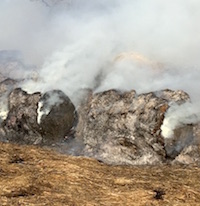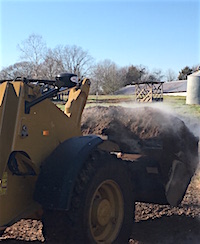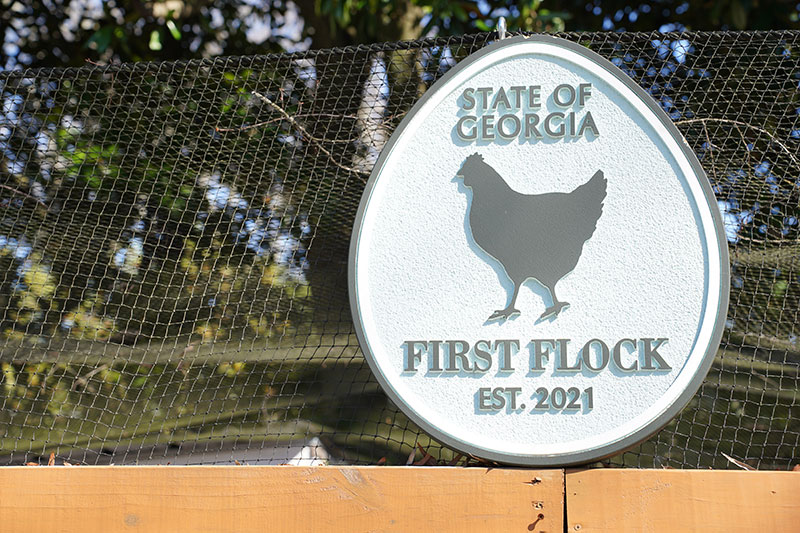Barn fires have long been known as a potential hazard of storing hay, but a recent barn fire in Madison County, Georgia, revealed another hazard — poultry litter.
It’s never good to get a call from the fire department, but at the end of January, the local fire station called the University of Georgia Cooperative Extension office in Madison County to discuss a fire at a nearby farm. The fire had started in a barn used to house poultry litter, hay and farm equipment.
The firefighters needed to know the best way to safely put out the fire while handling the poultry litter from an agricultural standpoint. I was curious as to how this all started; I was familiar with hay catching fire, but I was not aware of instances of fire caused by litter. While firefighters were still dealing with the fire later that day, I visited the farm to try to determine what happened.
The barn was an open-sided metal structure used to house hay for cattle, farm equipment, and poultry litter from the grower's poultry houses. My initial thoughts were that the hay had started the fire, but the timing didn’t make sense — hay would be more of an issue during haying season, when hay is fresh.
In this case, the poultry litter was the origin of the fire, but the litter itself never seemed to be engulfed in flames. The litter was stacked against wooden walls that separated it from about 100 rolls of hay. I believe the temperature inside the poultry litter rose high enough that the wooden wall became hot enough to ignite the hay. The fire destroyed much of the barn’s roof, damaged farm equipment and destroyed nearly all of the hay.
Neither the farmer nor the firefighters were hurt, and the fire provided a teachable moment for poultry producers and others who store hay and poultry litter.
A few tips from UGA Extension will hopefully help reduce the risk of a structure fire and potential injury or loss of property.
- Understand that litter and hay generate heat — Poultry litter and hay contain living organisms, or microscopic “bugs,” that generate heat as a result of their activities. In certain circumstances this heat can cause material like hay to spontaneously combust.
- Moisture is the issue — Fresh poultry litter can contain a fair amount of moisture. As the litter composts, much of that moisture evaporates or is used in the biological activities that generate heat. Litter with higher moisture levels can generate more heat. If litter is stored in open-air structures, place it where it won’t get wet. Remember, wetting litter won’t keep it from catching fire; the opposite is usually true.
- Don’t mix or stack wet material with dry material — In most situations where litter has caused a fire, fresh, wet litter was stacked against old, drier litter. Ignition can happen at this boundary. This process is known as the “heat of adsorption.” Heat releases as water vapor is adsorbed by the dry material. Keep fresh litter separate from old litter, either in a separate windrow or a different pile.
- Limit pile sizes — The larger the pile, the higher the chance for heat to build up to potential fire-causing levels. Pile height should not exceed 7 feet. If litter is piled against a wooden wall, the pile height should be limited to 4 feet. (I prefer litter not be stacked against a wooden wall. Leave a gap for air flow to dissipate heat.) Also, do not compact piles by driving equipment on them or packing them tightly with equipment.
- Monitor temperatures by investing in a high-quality temperature probe — Using a temperature probe to frequently monitor pile temperatures could prevent the loss of structures to a fire. Once any litter pile begins to reach temperatures near 190 degrees Fahrenheit or the pile begins to smolder, remove the material from the barn and contact the fire department or call 911. Disturbing a smoldering litter pile can expose it to oxygen and start a fire.
Poultry litter is a valuable by-product for farmers and is used as a soil amendment and fertilizer. Proper storage is important to keep a beneficial product from creating a fire hazard.
Following these guidelines and working with your local fire department to discuss emergency accessibility to your farm can make life safer on your land.








